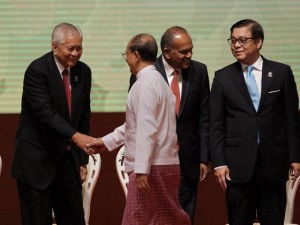THE Association of Southeast Asian Nations foreign ministers meeting formally opened in Naypyidaw, Myanmar, on Friday to find ways on how to ease tensions brought about by territorial rows between some Asean member-countries and China in the South China Sea (West Philippine Sea).
Myanmar President Thein Sein began the meeting with a plea for the regional bloc to strengthen its ability to push for “peaceful settlement of disputes and differences.”
“The current developments in the world are causing serious concern to us,” he said, without giving specific examples, in a speech in the capital Naypyidaw.
Earlier, the Philippines announced that it would pursue adoption of its proposed Triple Action Plan (TAP) in the Asean meeting.
Charles Jose, spokesman for the Philippine Department of Foreign Affairs, said in a news briefing that the Philippines is focused on the TAP, a three-part proposal that aims to deescalate tensions in the region and find a permanent solution to the disputes in the South China Sea.
Among the issues that TAP will address are reports that China is planning on constructing infrastructure on the Paracel Islands claimed by Vietnam and the Spratly Islands claimed by the Philippines.
The sea, which is criss-crossed by key international shipping lanes, is thought to hold huge oil and gas deposits and is claimed almost in its entirety by China.
Despite China’s earlier refusal to discuss the proposal, Jose said it remains important for the Philippines to present the TAP in the meeting.
Asean is composed of the Philippines, Brunei Darussalam, Cambodia, Indonesia, Laos, Malaysia, Myanmar, Singapore, Thailand and Vietnam.
Of the 10 Asean member-countries, four are claimant-countries--the Philippines, Vietnam, Malaysia and Brunei. China and Taiwan also have overlapping claims to the resource-rich waters.
“At least one good thing [that will result from the meeting] is that our concerns are being shared by other Asean countries. They also recognize the [importance of not] exacerbating tensions in the region and we should take all measures to deescalate the tensions that will result in eventual solution of the disputes,” Jose said.
He added that the Philippines hopes Asean will be able to convince China “to agree to cessation of activities that will ease the tensions.”
Jose noted that the Philippines has been “faithful” to the 2002 Declaration on the Code of Conduct (DOC) signed by Asean and China to reduce tensions in the region.
“We have not taken any unilateral actions to violate the DOC,” he said.
Freeze in activities in the region is the first part of the three-part action plan.
The second part is intermediate approach, which calls for full implementation of the 2002 DOC and the expeditious conclusion of a more binding Code of Conduct (COC).
The intermediate approach also aims to define more clearly Paragraph 5 in the DOC, which identifies activities that raise tensions and complicates the situation in the region.
China’s actions in the region have raised concerns from the international community and the claimant-countries, particularly the Philippines and Vietnam.
Manila earlier accused Beijing of “ambitious expansionism” by reclaiming Philippine-claimed territories such as Mabini Reef, Malvar Reef, Calderon Reef, Burgos Reed and Kennan Reef.
The third approach in the TAP is the proposal to find a “final solution” to the disputes, which have turned Southeast Asia as a potential military flashpoint.
“We expressed serious concern over recent developments in the South China Sea, which have raised tensions in the area,” an early draft statement to be discussed at the Asean foreign ministers’ meeting said.
In comments that could prove contentious among China’s allies in the 10-member bloc, the draft also called for cessation of “destabilizing actions” in the disputed waters.
The rig incident in May sent relations between Beijing and Hanoi plunging to their lowest point in decades and set off a wave of deadly anti-China riots in Vietnam.
China, which is attending the Naypyidaw meeting, has since removed its deep-sea oil rig from the waters near the Paracel Islands.
Foreign ministers of the Philippines, Malaysia, and Vietnam met informally in Naypyidaw late Thursday to reinforce a joint stance on the South China Sea.
“When we coordinate, our position becomes stronger,” a Southeast Asian diplomat said also on Friday when asked about the meeting.
But it was unclear if all member-states of the regional bloc would agree on the language as Asean operates on consensus.


